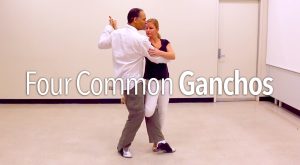The Crazy Vocabulary of Tango
Everyone likes the crazy stuff to learn. And no one likes to see the train wrecks that happen when the crazy stuff goes awry. This site has a load of that crazy stuff, and can help you to make what you have better. Tango Topics can give you a few ideas that you didn’t have before with over 800 videos and articles (not including all the other stuff) on Tango Topics watch and learn from. It’s not just the videos, but the articles that contain the most of what you need to know to elevate your dance. We’re not trying to sell you videos here, but instead to inform and engage you to educate yourself wherever possible.

Gooey Ganchos
What is a ‘Gooey’ Gancho ? In specific it means that while this particular variety is usually executed from the Follower’s position, the Lead can and should under certain conditions engage in the same variation but not for the same reasons that the Follower will. So what is it ? In specific it is a slow motion Gancho, and in particular the ‘Launching’ leg of the dancer who is being “Gancho’d”. Everything prior to the Gancho happening is not the ‘Gooey’ part. The ‘Gooey’ part comes when the leg that is being lifted moves to engage the hooking action of the Gancho in a very slow, but very deliberate way. Very slow. 🙂

Golden Nugget Extensions
What is a Golden Nugget Extension ? The title is a both a double-entendre as well as a deliberate explanation of what it is. First, it’s taking the Golden Nugget and adding an expansion pack to it. Things you probably hadn’t thought of when playing with The Golden Nugget. Secondly, it’s adding extensions to everything, everywhere!

Four Common Ganchos
Gancho. The word in Spanish translates to the English word, roughly, as ‘Hook’. From an Argentine Tango perspective it has a very specific meaning. You’ve seen these things hundreds of times, and while the vocabulary itself has a connotation as being somewhat ‘cheesy’, and only done by beginner leads who don’t know any better, the reality is a that it is a venerable piece of Tango vocabulary that do have a valid place off the main trunk of the Tango history tree. The story goes that while the Gancho existed long before Norberto “El Pulpo” Esbrez came along, his contribution to its storied history is where creativity meets innovation, specifically with regards to ‘elasticity’ and the Enganche. He is/was credited with pioneering and exploration the ‘invasion’ of the standing leg, the response of the free leg, as well as the space in between the opening of a step, and quite factually (if not literally), the intersection of these ideas.

Circular Boleos
What is a Circular Boleo ? This is a lifting of the leg (Lead or Follow, typically though it’s the Follower’s leg) that tends to curve (hence the circular part) up and sometimes around the Lead. This is why they’re called "Circular" Boleos. In this version of the Circular Boleo, we’re exploring a Mid-Range Circular Boleo or what Tango Topics refers to as a Mid-Height Circular Boleo.

Argentine Wraps
What is an Argentine Enganche ? The Enganche can be but is not limited to where the dancers’s free leg, can wrap around their partner’s leg in a myriad of different ways through either a Gancho, a Ganchito, a Rebound, un Libre Pierna (a free leg) Columpio (swing), or a version of a Sacada, or a Wrap in the English sense of the word. However the Argentine Wrap is a bit more specific in that it is very limited, this is where the Lead, or the Follower, mostly the Follower in this instance, can and will wrap their free leg around their partner usually from a side step. However a Wrap can be achieved from either back or forward steps as well however it is slightly more challenging to do so.

Argentine Volcadas
What is a Volcada ? When done properly….and ‘proper’ is a very loose word here because there a whole series of volcadas that can be done (safely) that loosely qualify as a Volcada. These are what are considered shared-axis pieces of tango vocabulary that result in a series of crossed feet for the Follower to either Follower left or Follower right.

Argentine Paradas
The word ‘parada’ translates into English as ‘stopped’. And that’s exactly what it is. A stop. From a Tango perspective this is a well worn piece of tango vocabulary that most people see as an element towards engaging the illusion of ‘intimacy’ of the dance, or it’s ‘steamy’ aspects. Anyone inside the dance knows that the ‘steamy’ thing is just that, an illusion, and that there’s real work to be done to make this venerable piece of tango vocabulary useful and musical. The vocabulary gets its name from the fact that we are stopping but it’s an unusual stop. It’s a stop not because you’re stopping the Lead’s motion, but in fact stopping the Follower’s motion. It’s more of an interruption really, because the ‘stop’ is momentary. With that thought in mind, let’s talk “Paradas”, what they are and how they’re useful for both roles of the dance.

Argentine Barridas
The word ‘barrida’ translates into English as ‘swept’. And that’s exactly what it is. A sweep. From a Tango perspective this is a somewhat ‘worn’ piece of tango vocabulary that most people see sort of schlock tango schtick. Most people start out with doing it a few times, and then disregard it because they’ve moved on to something else that’s more ‘flashy’. The Barrida is, in common vernacular, a ‘drag’ of the foot (either role can initiate it). And does have a useful application in the dance which is purely musical if not entirely navigational. With that thought in mind, let’s talk “Barridas”, what they are and how they’re useful for both roles of the dance.
